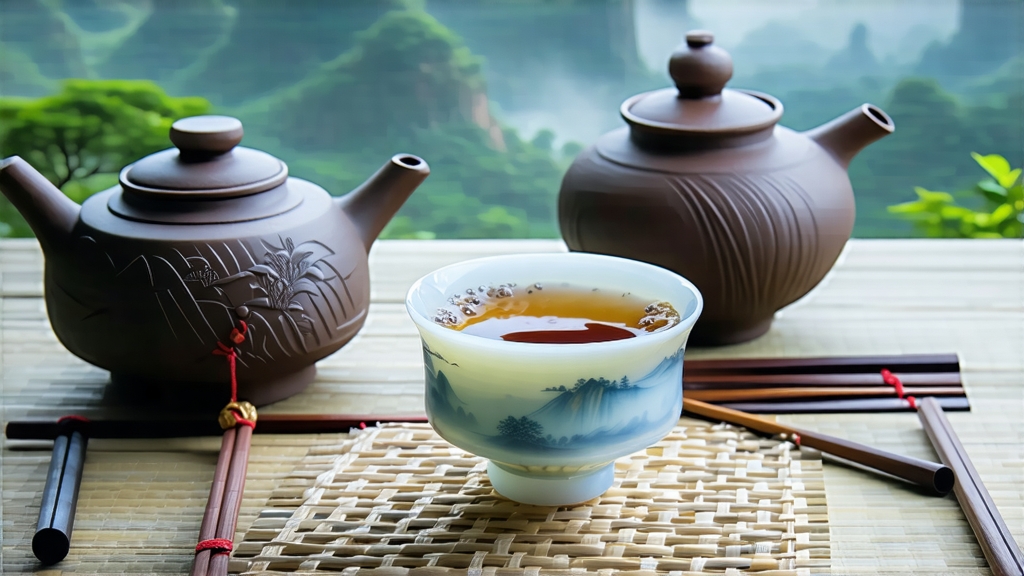
Tucked away in the humid, karst-wrapped counties of southern Guangxi, Liubao cha has spent four centuries quietly perfecting the art of post-fermentation while its better-known cousin Pu-erh soaked up the limelight. To international drinkers who equate “dark tea” solely with Yunnan’s bounties, Liubao offers a mellower, more camphor-bright pathway into the world of heicha, one that carries the scent of betel nut, rain-soaked bamboo and the vanilla-tinged breath of long-aged camphor wood.
History: From Border Caravan to Imperial Tribute
The name first appears in a 1640 county gazetteer that records “large jars of dark leaf shipped west to Sichuan and east along the Pearl River.” By the late Qing, Liubao’s ability to settle stomachs after greasy canal-boat meals had turned it into a currency of its own; boatmen paid wharf fees with compressed bricks rather than silver. When the 1886 Canton Trade Fair opened, Liubao was the only heicha entered under the imperial customs code “black brick, Guangxi origin,” and it rode the same mule caravans that carried opium and musk to the hill markets of northern Indochina. The opening of the Hong Kong–Canton railway in 1911 shifted the route southward; jars marked “Lau Pau” (the Cantonese pronunciation) disappeared into the holds of steamers bound for Singapore, Kuala Lumpur and finally the tin-mines of Perak, where coolies swore it prevented malaria.
Micro-terroirs within one county
Liubao County is no bigger than Luxembourg, yet within its folded valleys four distinct sub-styles have evolved:
- Mountain Shade Style (Shan Yin): gardens above 400 m wrapped in camphor and cinnamon forest. Leaf picks up a cooling, almost minty note from companion trees.
- Riverside Mist Style (He Wu): terraces along the Xun River where night fog re-hydrates withered leaves, intensifying amino acids and deepening the signature betel-nut finish.
- Old Arbor Style (Gu Shu): scattered 200- to 400-year-old trees on communal land. Farmers climb rather than prune, yielding small, purple-veined leaves that age into syrupy jujube sweetness.
- Terrace Rain-Fed Style (Tian Yuan): low-elevation bushes planted in the 1970s. Faster growing, they provide the backbone for mass-market “workman’s brick” yet still receive the traditional wet-pile, making them an affordable entry point.
Craft: When microbes outnumber farmers
The journey from fresh leaf to drinkable Liubao is a dialogue between human gesture and microbial ambition.
- Plucking: only the standard “one bud with three or four leaves” is taken; the older leaves carry the polyphenols that Ralstonia and Bacillus strains will later convert into theaflavins and theabrownins.
- Indoor withering: 8–10 h on waist-high bamboo racks in a room kept at 28 °C and 75 % RH. The goal is not oxidation but pre-fermentation hydration; stems turn ruby-red and exude a faint lychee scent.
- Kill-green: 3 min in a 200 °C wok, enough to denature polyphenol oxidase yet leave surface microbes intact. A quick “sha qing” sets the stage for true post-fermentation rather than black-tea oxidation.
- Rolling: forty minutes of machine twisting followed by ten minutes of foot-rolling inside a hemp sack, a step that fractures cell walls without pulverizing them, creating highways for later microbial colonization.
- Sun-fixing: leaves are spread on coconut-leaf mats for a single day of direct subtropical sun. UV light triggers Streptomyces spores that will dominate the aging cellar.
- Wet-pile (Wo Dui): the signature 25-day microbial sauna. Leaves are piled 70 cm high, misted to 35 % moisture, and covered with jute. Internal temperature climbs to 58 °C before being turned twice daily. Unlike Pu-erh’s shorter 4-week cycle, Liubao’s pile is cooler and longer, encouraging a lactic-acid phase that softens astringency and builds the famous “betel-nut” note.
- Air-rest: after piling, leaves are